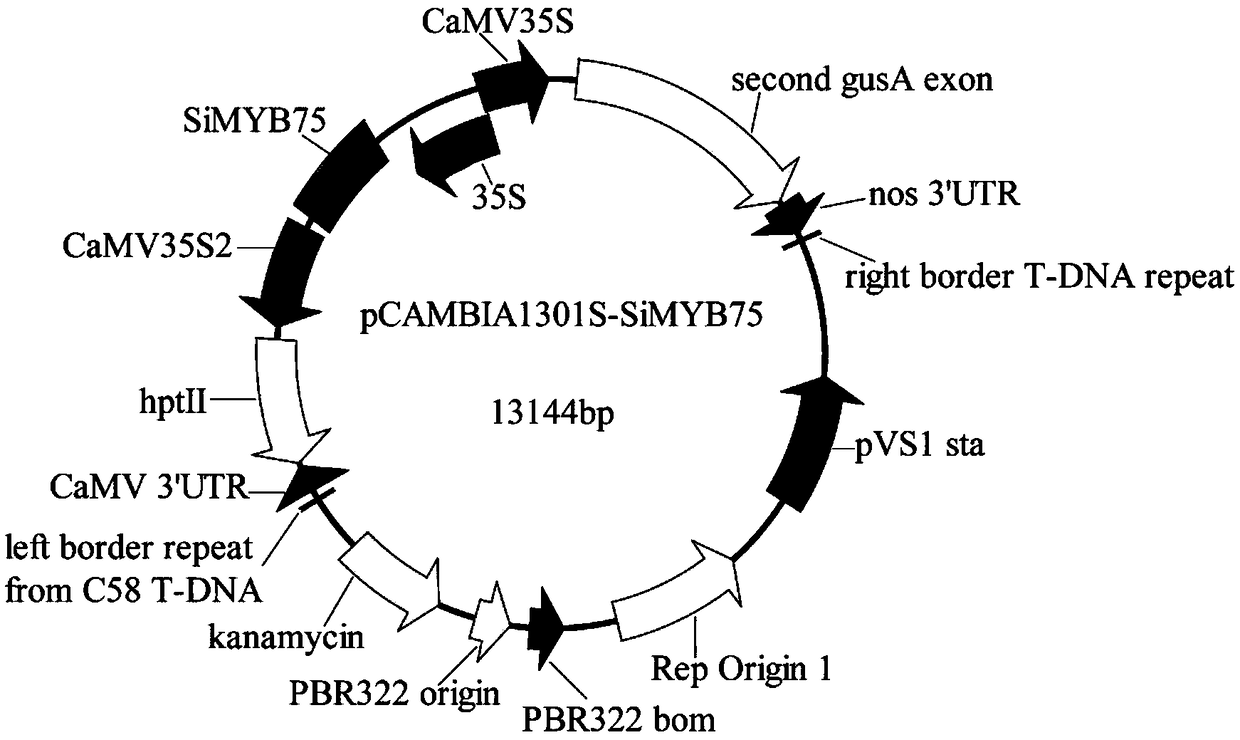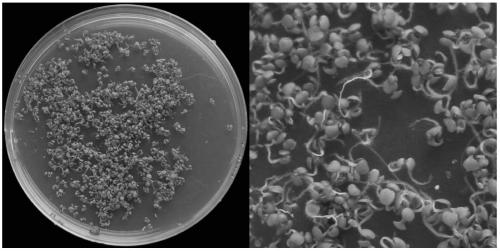Sesame drought resisting and salt-tolerant gene SiMYB75 as well as encoded protein and application thereof
A salt-tolerant gene and sesame technology, applied in the field of genetic engineering, can solve the problems of weak abiotic stress research and few molecular-related research on sesame, improve drought resistance and salt tolerance, ensure high and stable yield, and improve drought resistance and salt tolerance. Effect
- Summary
- Abstract
- Description
- Claims
- Application Information
AI Technical Summary
Problems solved by technology
Method used
Image
Examples
Embodiment 1
[0031] Example 1 Acquisition of Sesame Drought Resistance and Salt Tolerance Gene SiMYB75 Gene
[0032] 1. Discovery of the drought-resistant and salt-tolerant gene SiMYB75 in sesame
[0033] 1. A pair of sesame drought-resistant material ZZM0635 and drought-sensitive material ZZM4728 were selected, potted and planted in an arid shed, and subjected to drought stress treatment at the initial flowering stage (47 days after sowing). Take d0 (soil moisture content 35%), d1 (soil moisture content 15%), d2 (soil moisture content 9%), d3 (soil moisture content 6%) and d4 (soil moisture content 35% after rehydration)5 The leaves of two materials at each time point were used for drought-resistant transcriptome analysis;
[0034] 2. Use the Illumina Hiseq4000 sequencing platform to perform transcriptome sequencing on 30 samples, and each sample produces an average of 6.86Gb of data. After aligning the sequencing reads to the sesame reference genome and reconstructing the transcripts, ...
Embodiment 2
[0041] Example 2 Construction and genetic transformation of SiMYB75 gene expression vector
[0042] 1. Construction of overexpression vector
[0043] The drought-resistant and salt-tolerant related sesame gene SiMYB75 that embodiment 1 is cloned utilizes the method for homologous recombination and pCAMBIA1301S (provided by this laboratory) plasmid connection construction plant expression vector, named after pCAMBIA1301S-SiMYB75 ( figure 1 ), the specific operations are as follows:
[0044] 1. First, the linearized vector was obtained by double enzyme digestion (BamHI and KpnI) (Takara), and then purified by agarose gel electrophoresis and gel recovery kit (Tiangen Biochemical Technology Co., Ltd.) to obtain a high-purity linearized vector.
[0045] 2. Add the DNA of the target fragment and the linearized carrier to a 1.5ml centrifuge tube at a molar ratio of 3:1 for recombination reaction, mix well and place it at 37°C for about 30min, add 10μl of the reaction solution to 50μ...
Embodiment 3
[0082]Implementation 3 Determination of Drought Resistance and Salt Tolerance of Positive Plants of SiMYB75 Overexpression Transgenic T2 Generation Families
[0083] 1. Determination of drought resistance of T2 generation positive Arabidopsis plants
[0084] After the transgenic plants of the T2 generation grew to the stage of three pairs of leaves, the transgenic Arabidopsis plants and the non-transgenic wild-type Arabidopsis plants were subjected to drought stress treatment for 17 days. The results showed that compared with the wild-type Arabidopsis control, the drought resistance of the SiMYB75-transgenic Arabidopsis lines obtained in this study was significantly higher than that of the wild-type Arabidopsis control ( Figure 8 ), indicating that the overexpression of SiMYB75 gene in sesame can improve the drought resistance of plants.
[0085] 2. Determination of Salt Tolerance of T2 Generation Positive Arabidopsis Plants
[0086] After the transgenic plants of the T2 ge...
PUM
 Login to View More
Login to View More Abstract
Description
Claims
Application Information
 Login to View More
Login to View More - R&D
- Intellectual Property
- Life Sciences
- Materials
- Tech Scout
- Unparalleled Data Quality
- Higher Quality Content
- 60% Fewer Hallucinations
Browse by: Latest US Patents, China's latest patents, Technical Efficacy Thesaurus, Application Domain, Technology Topic, Popular Technical Reports.
© 2025 PatSnap. All rights reserved.Legal|Privacy policy|Modern Slavery Act Transparency Statement|Sitemap|About US| Contact US: help@patsnap.com



